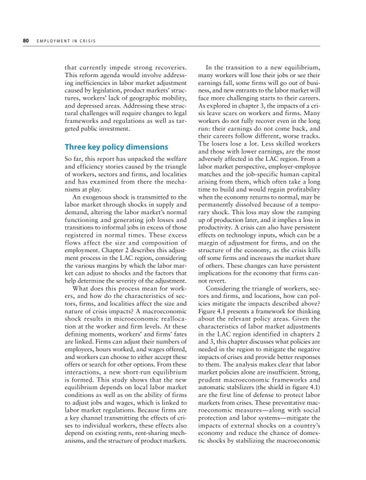80 E m p l o y m e n t
in Crisis
that currently impede strong recoveries. This reform agenda would involve addressing inefficiencies in labor market adjustment caused by legislation, product markets’ structures, workers’ lack of geographic mobility, and depressed areas. Addressing these structural challenges will require changes to legal frameworks and regulations as well as targeted public investment.
Three key policy dimensions So far, this report has unpacked the welfare and efficiency stories caused by the triangle of workers, sectors and firms, and localities and has examined from there the mechanisms at play. An exogenous shock is transmitted to the labor market through shocks in supply and demand, altering the labor market’s normal functioning and generating job losses and transitions to informal jobs in excess of those registered in normal times. These excess flows affect the size and composition of employment. Chapter 2 describes this adjustment process in the LAC region, considering the various margins by which the labor market can adjust to shocks and the factors that help determine the severity of the adjustment. What does this process mean for workers, and how do the characteristics of sectors, firms, and localities affect the size and nature of crisis impacts? A macroeconomic shock results in microeconomic reallocation at the worker and firm levels. At these defining moments, workers’ and firms’ fates are linked. Firms can adjust their numbers of employees, hours worked, and wages offered, and workers can choose to either accept these offers or search for other options. From these interactions, a new short-run equilibrium is formed. This study shows that the new equilibrium depends on local labor market conditions as well as on the ability of firms to adjust jobs and wages, which is linked to labor market regulations. Because firms are a key channel transmitting the effects of crises to individual workers, these effects also depend on existing rents, rent-sharing mechanisms, and the structure of product markets.
In the transition to a new equilibrium, many workers will lose their jobs or see their earnings fall, some firms will go out of business, and new entrants to the labor market will face more challenging starts to their careers. As explored in chapter 3, the impacts of a crisis leave scars on workers and firms. Many workers do not fully recover even in the long run: their earnings do not come back, and their careers follow different, worse tracks. The losers lose a lot. Less skilled workers and those with lower earnings, are the most adversely affected in the LAC region. From a labor market perspective, employer-employee matches and the job-specific human capital arising from them, which often take a long time to build and would regain profitability when the economy returns to normal, may be permanently dissolved because of a temporary shock. This loss may slow the ramping up of production later, and it implies a loss in productivity. A crisis can also have persistent effects on technology inputs, which can be a margin of adjustment for firms, and on the structure of the economy, as the crisis kills off some firms and increases the market share of others. These changes can have persistent implications for the economy that firms cannot revert. Considering the triangle of workers, sectors and firms, and locations, how can policies mitigate the impacts described above? Figure 4.1 presents a framework for thinking about the relevant policy areas. Given the characteristics of labor market adjustments in the LAC region identified in chapters 2 and 3, this chapter discusses what policies are needed in the region to mitigate the negative impacts of crises and provide better responses to them. The analysis makes clear that labor market policies alone are insufficient. Strong, prudent macroeconomic frameworks and automatic stabilizers (the shield in figure 4.1) are the first line of defense to protect labor markets from crises. These preventative macroeconomic measures—along with social protection and labor systems—mitigate the impacts of external shocks on a country’s economy and reduce the chance of domestic shocks by stabilizing the macroeconomic

